Molecular-Theory of High Frequency Dielectric Susceptibility of Nematic Nanocomposites
Abstract
1. Introduction
2. Results
2.1. High Frequency Dielectric Susceptibility of the Nematic Nanocomposite
2.2. Effective Polarizability of a Nanoparticle in the Nematic Liquid Crystal Medium
2.3. Shifting of the Plasmon Resonance Frequency in the Nematic Matrix
3. Discussion
Author Contributions
Funding
Acknowledgments
Conflicts of Interest
Abbreviations
| MDPI | Multidisciplinary Digital Publishing Institute |
| DOAJ | Directory of open access journals |
Appendix A. Dispersion of the Dielectric Susceptibility in the Pure Nematic Host 5CB and in the Nematic Mixture
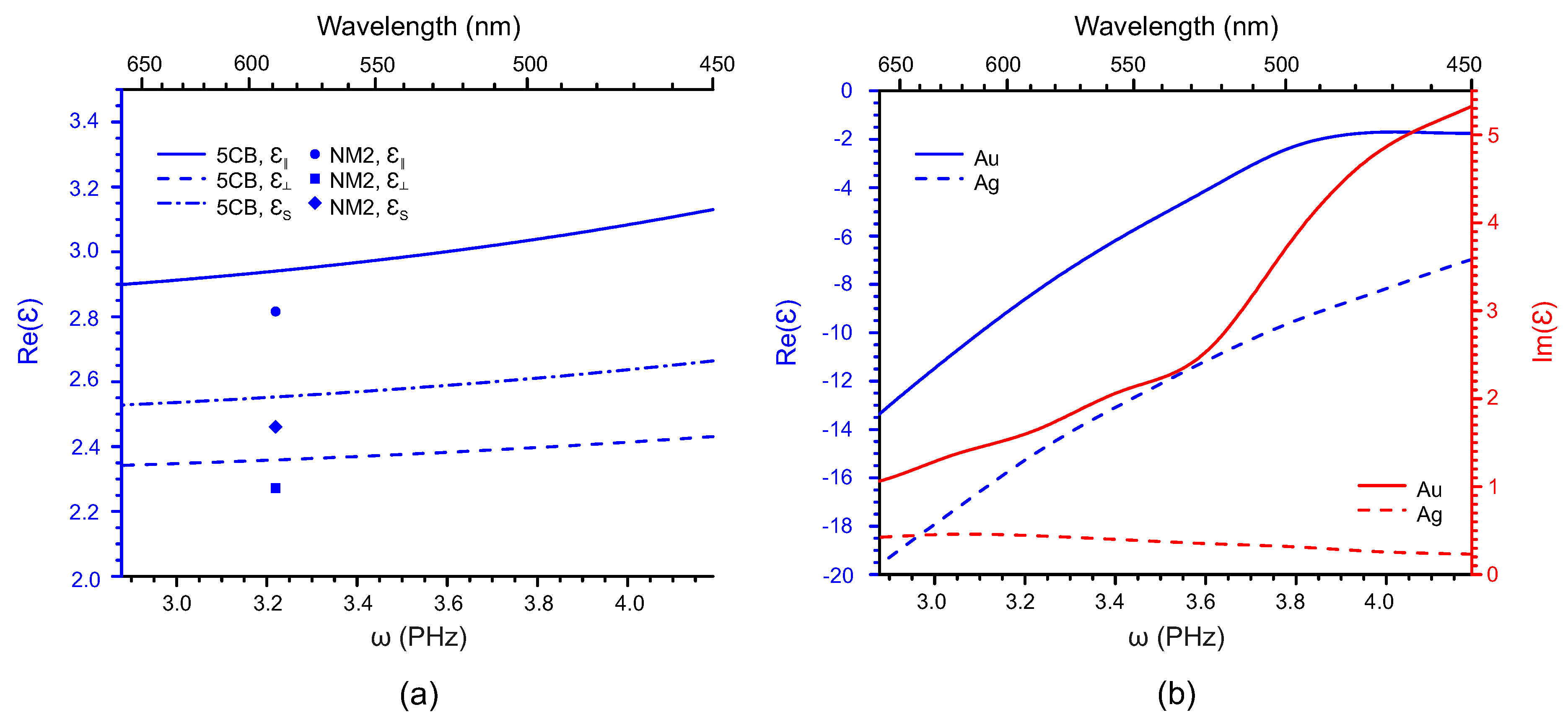
References
- Qi, H.; Kinkead, B.; Hegmann, T. Effects of functionalized metal and semiconductor nanoparticles in nematic liquid crystal phases. Proc. SPIE 2008, 6911, 691106. [Google Scholar]
- Qi, H.; Hegmann, T. Formation of periodic stripe patterns in nematic liquid crystals doped with functionalized gold nanoparticles. J. Mater. Chem. 2006, 16, 4197–4205. [Google Scholar] [CrossRef]
- Shiraishi, Y.; Toshima, N.; Maeds, H.; Yoshikawa, K.; Xu, J.; Kobayashi, S. Frequency modulation response of a liquid-crystal electro-optic device doped with nanoparticles. Appl. Phys. Lett. 2002, 81, 2845–2847. [Google Scholar] [CrossRef]
- Kobayashi, S.; Toshima, N. Nanoparticles and lcds: It’s a surprising world. Inf. Disp. 2007, 23, 26. [Google Scholar]
- Yoshida, H.; Kawamoto, K.; Kubo, H.; Tsuda, A.; Fujii, T.A.; Kuwabata, S.; Ozaki, M. Nanoparticle-dispersed liquid crystals fabricated by sputter doping. Adv. Mater. 2010, 22, 622–626. [Google Scholar] [CrossRef] [PubMed]
- Kaur, S.; Singh, S.P.; Biradar, A.M.; Choudhary, A.; Sreeniva, K. Enhanced electro-optical properties in gold nanoparticles doped ferroelectric liquid crystals. Appl. Phys. Lett. 2007, 91, 023120. [Google Scholar] [CrossRef]
- Kumar, A.; Prakash, J.; Mehta, A.M.; Biradar, D.S.; Haase, W. Enhanced photoluminescence in gold nanoparticles doped ferroelectric liquid crystals. Appl. Phys. Lett. 2009, 95, 023117. [Google Scholar] [CrossRef]
- Buchnev, O.; Dyadyusha, A.; Kaczmarek, M.; Reshetnyak, V.; Reznikov, Y. Enhanced two-beam coupling in colloids of ferroelectric nanoparticles in liquid crystals. J. Opt. Soc. Am. B 2007, 24, 1512–1516. [Google Scholar] [CrossRef]
- Reznikov, Y.; Buchnev, O.; Tereshchenko, O.; Reshetnyak, V.; Glushchenko, A.; West, J. Ferroelectric nematic suspension. Appl. Phys. Lett. 2003, 82, 1917–1919. [Google Scholar] [CrossRef]
- Li, F.; Buchnev, C.; Cheon, O.; Glushchenko, A.; Reshetnyak, V.; Reznikov, Y.; Sluckin, T.; West, J. Orientational coupling amplification in ferroelectric nematic colloids. Phys. Rev. Lett. 2006, 97, 147801. [Google Scholar] [CrossRef]
- Lopatina, L.; Selinger, J. Theory of ferroelectric nanoparticles in nematic liquid crystals. Phys. Rev. Lett. 2009, 102, 197802. [Google Scholar] [CrossRef] [PubMed]
- Yoshida, H.; Tanaka, Y.; Kawamoto, H.T.T.; Kubo, K.; Fujii, A.; Kuwabata, S.; Kikuchi, H.; Ozaki, M. Nanoparticle-stabilized cholesteric blue phases. Appl. Phys. Express 2009, 2, 121501. [Google Scholar] [CrossRef]
- Wiersma, S. The physics and applications of random lasers. Nat. Phys. 2008, 4, 359–367. [Google Scholar] [CrossRef]
- Shandryuk, G.A.; Matukhina, E.V.; Vasil’ev, R.B.; Rebrov, A.; Bondarenko, G.N.; Merekalov, A.S.; Gas’kov, A.; Talroze, R. Effect of h-bonded liquid crystal polymers on cdse quantum dot alignment within nanocomposite. Macromolecules 2008, 41, 2178–2185. [Google Scholar] [CrossRef]
- Tal’roze, R.V.; Shandryuk, G.A.; Merekalov, A.S.; Shatalova, A.M.; Otmakhova, O.A. Alignment of nanoparticles in polymer matrices. Polym. Sci. Ser. A 2009, 51, 1194–1203. [Google Scholar] [CrossRef]
- Cai, W.; Shalaev, V. Optical Metamaterials: Fundamentals and Applications; Springer: Berlin/Heidelberg, Germany, 2009. [Google Scholar]
- Pratibha, R.; Park, K.; Smalykh, I.; Park, W. Tunable optical metamaterial based on liquid crystal-gold nanosphere composite. Opt. Express 2009, 17, 19459–19469. [Google Scholar] [CrossRef] [PubMed]
- Kossyrev, A.; Yin, P.A.; Cloutier, S.G.; Cardimona, D.A.; Huang, D.; Alsing, P.M.; Xu, J.M. Electric field tuning of plasmonic response of nanodot array in liquid crystal matrix. Nano Lett. 2005, 5, 1978–1981. [Google Scholar] [CrossRef]
- Chu, C.Y.; Chao, K.C.A.; Chen, Y.F.; Wu, Y.C.; Chen, C.C. Electrically controlled surface plasmon resonance frequency of gold nanorods. Appl. Phys. Lett. 2006, 89, 103107. [Google Scholar] [CrossRef]
- Israelachvili, J. Intermolecular and Surface Forces; Academic Press: Cambridge, MA, USA, 2011. [Google Scholar]
- Osipov, M.A.; Gorkunov, M.V. Effect of nanoparticle chain formation on dielectric anisotropy of nematic composites. Phys. Rev. E 2015, 92, 032501. [Google Scholar] [CrossRef]
- Landau, L.D.; Lifshits, E.M. Electrodynamics of Continuous Media; Pergamon Press: Oxford, UK, 1960. [Google Scholar]
- Mie, G. Beiträge zur Optik trüber Medien, speziell kolloidaler Metallösungen. Ann. Phys. 1908, 330, 377. (In German) [Google Scholar] [CrossRef]
- PJohnson, B.; Christy, R.W. Optical constants of the noble metals. Phys. Rev. B 1972, 6, 4370–4379. [Google Scholar] [CrossRef]
- Li, J.; Wen, C.H.; Gauza, S.; Lu, R.; Wu, S.T. Refractive indices of liquid crystals for display applications. J. Disp. Technol. 2005, 1, 51–61. [Google Scholar] [CrossRef]
- Bezborodov, V.S.; Mikhalyonok, S.G.; Kuz’menok, N.M.; Arol, A.S.; Shandryuk, G.A.; Merekalov, A.S.; Otmakhova, O.A.; Bondarenko, G.N.; Talroze, R.V. Anisotropic derivatives of (-)-L-lactic acid and their nanocomposites. Liq. Cryst. 2018, 45, 1223–1233. [Google Scholar]
- Osipov, M.A.; Gorkounov, M.V. Nematic Liquid Crystals Doped With Nanoparticles: Phase Behavior and Dielectric Properties Liquid Crystals with Nano and Microparticles; Lagerwall, J.P.F., Scalia, G., Eds.; World Scientific Publishing Company: Singapore, 2016; p. 41. [Google Scholar]

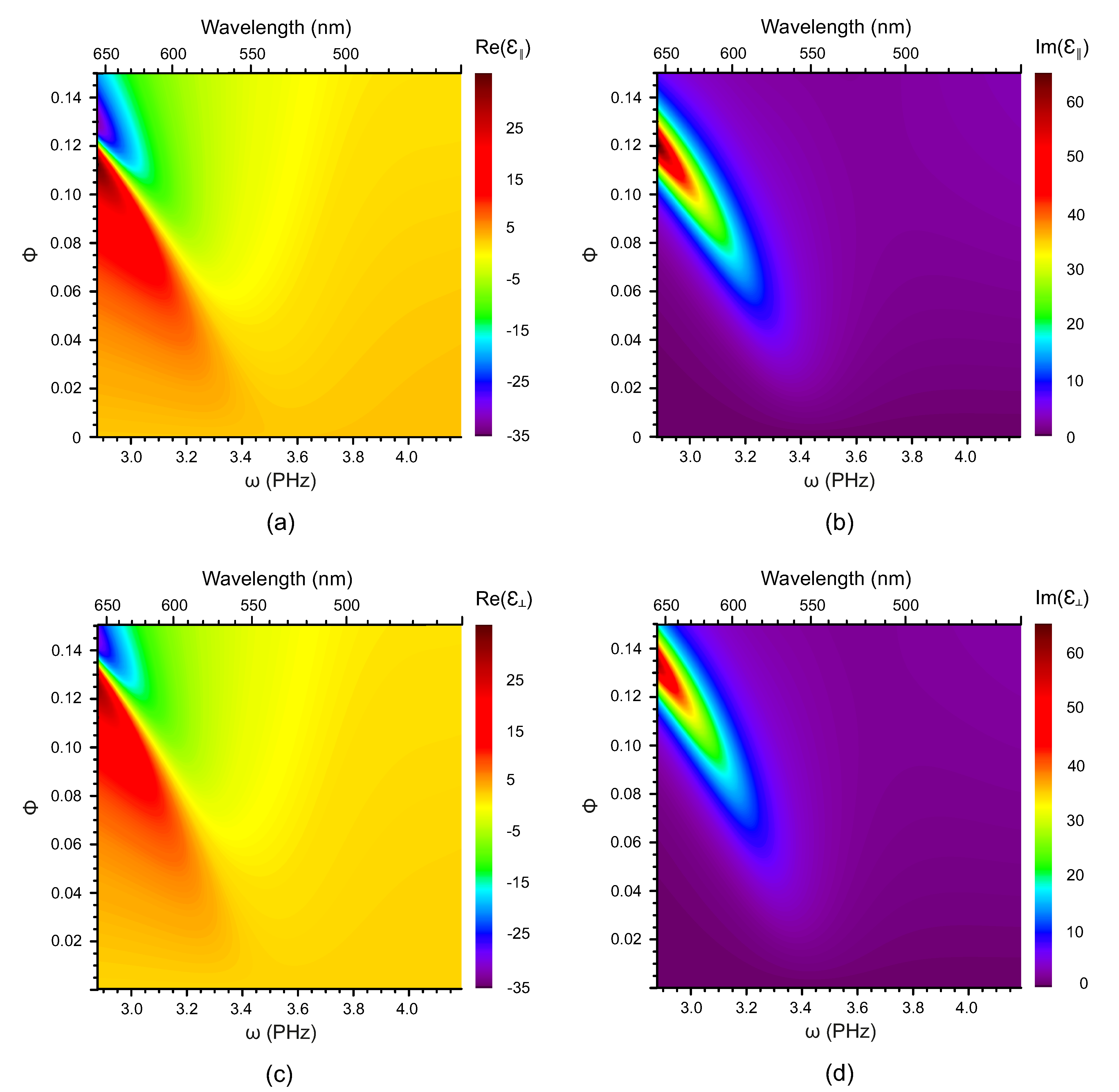
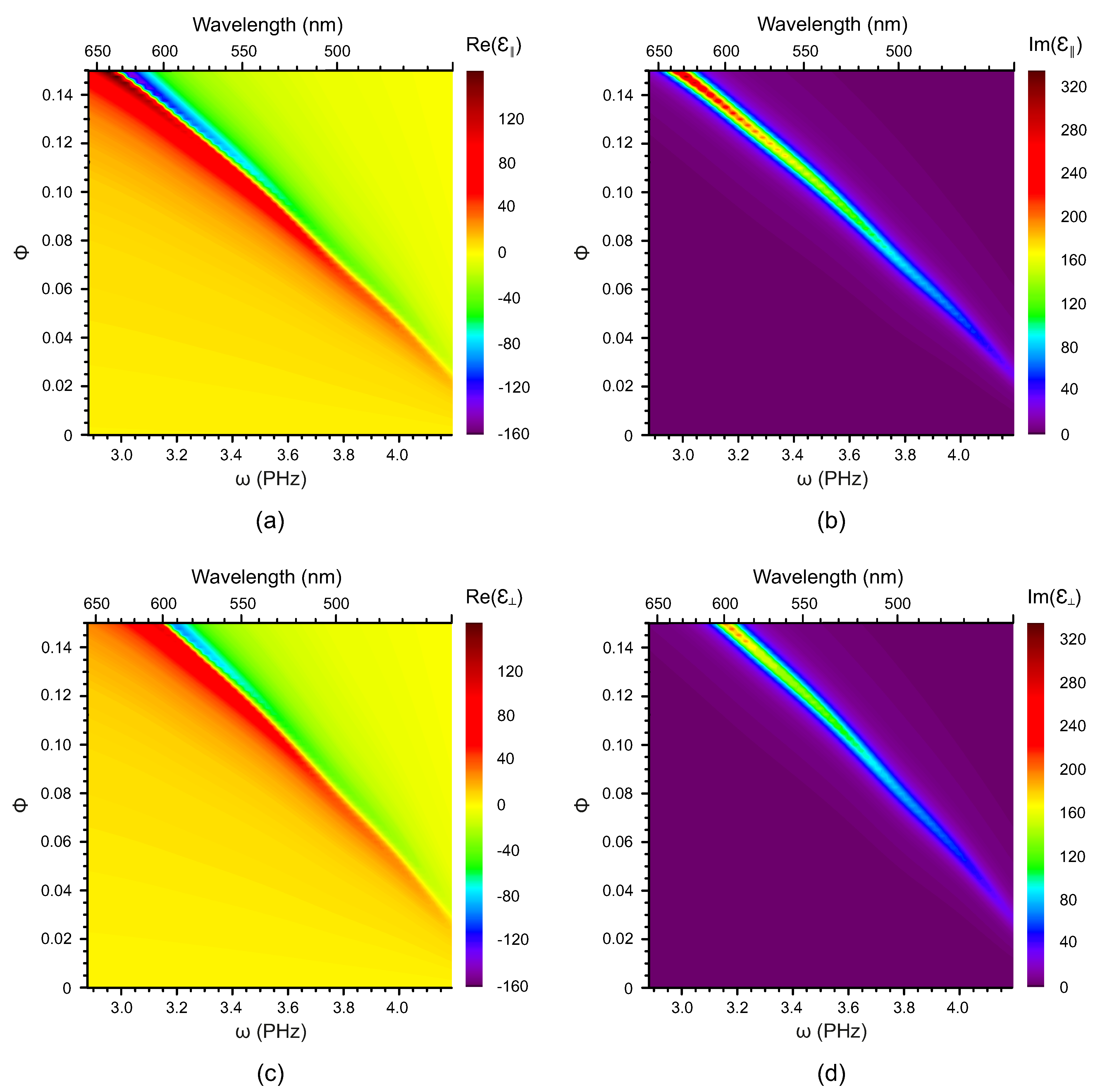

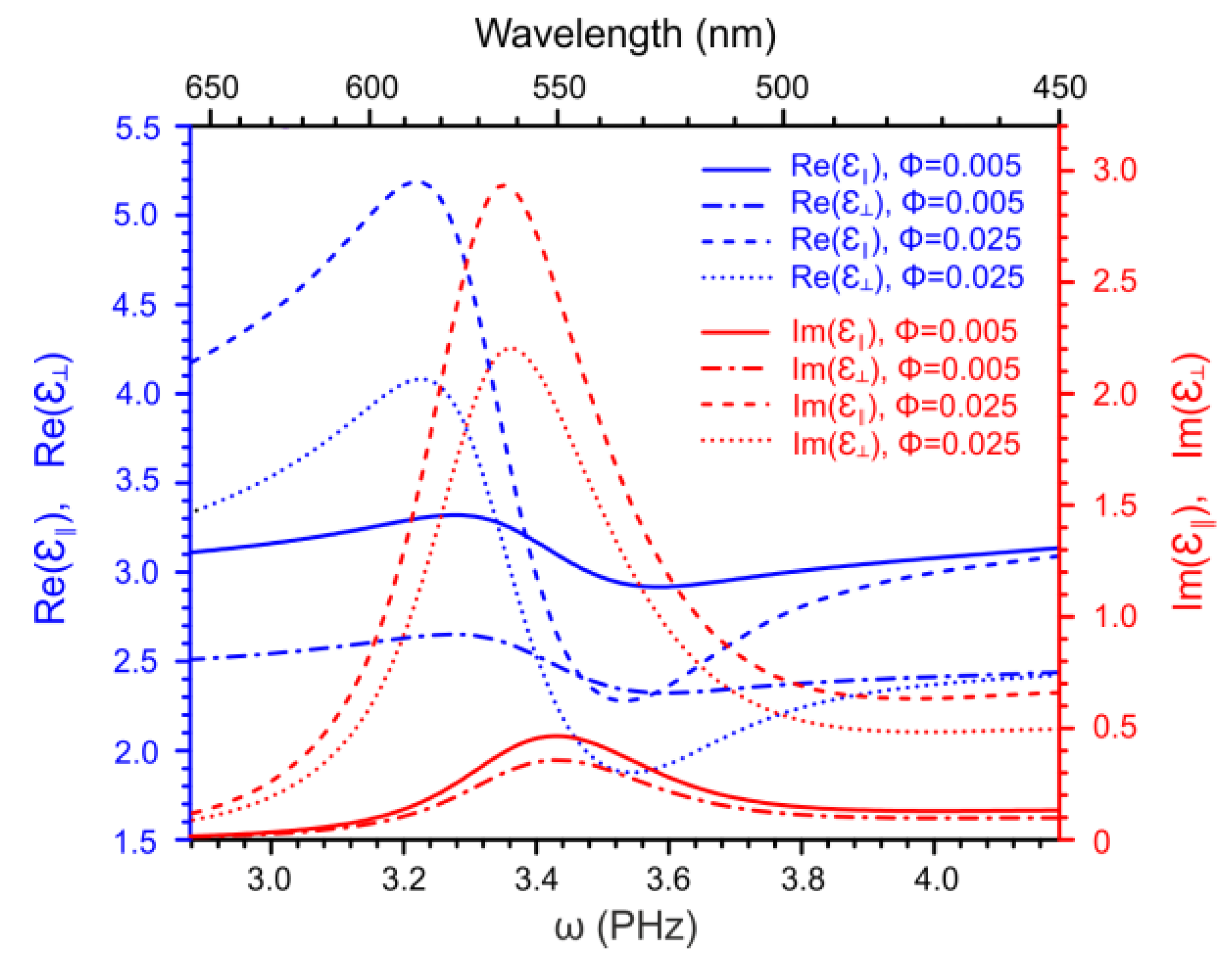
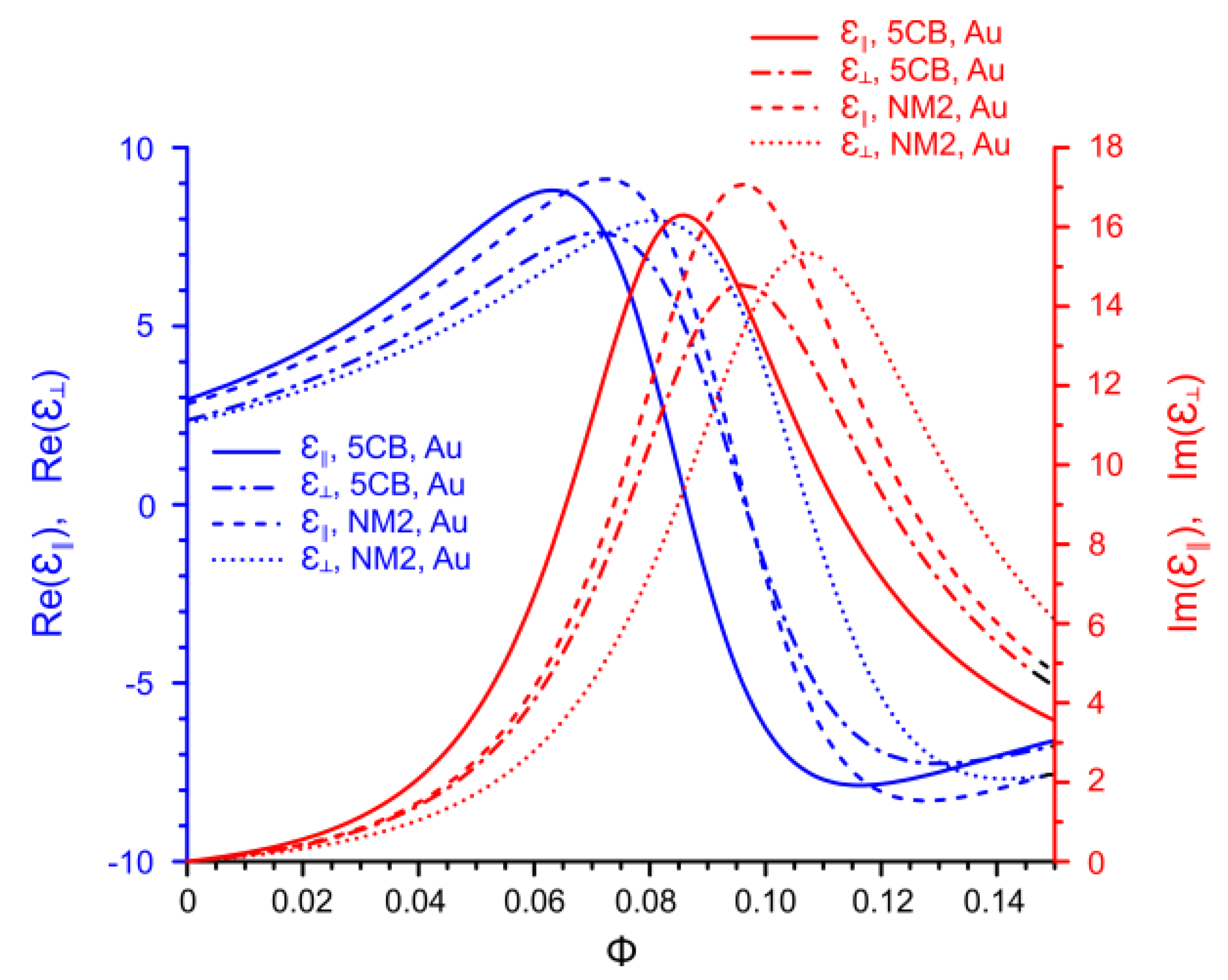
Publisher’s Note: MDPI stays neutral with regard to jurisdictional claims in published maps and institutional affiliations. |
© 2020 by the authors. Licensee MDPI, Basel, Switzerland. This article is an open access article distributed under the terms and conditions of the Creative Commons Attribution (CC BY) license (http://creativecommons.org/licenses/by/4.0/).
Share and Cite
Osipov, M.A.; Merekalov, A.S.; Ezhov, A.A. Molecular-Theory of High Frequency Dielectric Susceptibility of Nematic Nanocomposites. Crystals 2020, 10, 970. https://doi.org/10.3390/cryst10110970
Osipov MA, Merekalov AS, Ezhov AA. Molecular-Theory of High Frequency Dielectric Susceptibility of Nematic Nanocomposites. Crystals. 2020; 10(11):970. https://doi.org/10.3390/cryst10110970
Chicago/Turabian StyleOsipov, Mikhail A., Alexey S. Merekalov, and Alexander A. Ezhov. 2020. "Molecular-Theory of High Frequency Dielectric Susceptibility of Nematic Nanocomposites" Crystals 10, no. 11: 970. https://doi.org/10.3390/cryst10110970
APA StyleOsipov, M. A., Merekalov, A. S., & Ezhov, A. A. (2020). Molecular-Theory of High Frequency Dielectric Susceptibility of Nematic Nanocomposites. Crystals, 10(11), 970. https://doi.org/10.3390/cryst10110970





